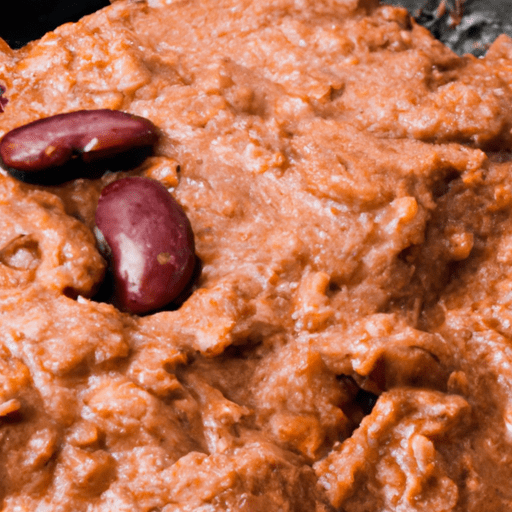The Delicious Delight of Refried Beans
Refried beans, a staple in Mexican cuisine, are a mouthwatering delight that can elevate any dish. While the name might suggest they are fried twice, they are actually only fried once, making them a satisfying and nutritious addition to your dining table. In this blog post, we will embark on a journey to uncover the delicious taste, common uses, nutritional value, and fascinating history surrounding refried beans.
The Taste of Refried Beans
When it comes to flavor, refried beans shine with a rich and comforting taste. The cooking process involves simmering pinto or black beans with aromatic spices, such as garlic, cumin, and chili powder. These seasonings infuse the beans with a robust and savory essence that dances on your palate. The beans are then mashed and cooked to perfection, resulting in a creamy and velvety texture. The natural creaminess of the beans combined with the layers of flavors exemplifies the outstanding taste of refried beans.
Versatile Uses in Cooking
Refried beans are extremely versatile, making them a beloved ingredient in various Mexican dishes. They serve as a fundamental component of classics such as burritos, tacos, enchiladas, and tostadas. A spoonful of refried beans can add an indulgent touch to your morning breakfast burrito, acting as a binding agent that holds the fillings together. Furthermore, they make a delightful dip for tortilla chips, creating a crowd-pleasing party appetizer.
Aside from traditional Mexican dishes, refried beans can also be incorporated into fusion cuisines. They can be used as a spread on sandwiches, a filling for quesadillas, or even as a topping for a hearty bowl of nachos. The possibilities are endless when it comes to the culinary applications of refried beans, highlighting their adaptability in creating mouthwatering and diverse dishes.
Nutritional Value
Refried beans offer more than just delectable flavor; they are also a nutrient-dense addition to your diet. Pinto beans, commonly used in refried bean recipes, are an excellent source of plant-based protein, dietary fiber, and essential minerals. Their high fiber content aids in digestion and helps maintain a healthy gut. Additionally, they boast a low glycemic index, which means they provide a slow and steady release of energy, making them suitable for individuals managing blood sugar levels.
Moreover, refried beans are cholesterol-free and low in saturated fat, making them heart-healthy. They are also rich in iron, magnesium, and potassium, essential minerals that contribute to overall well-being. So, by including refried beans in your meals, you not only savor their delightful taste but also reap the nutritional benefits they offer.
A Brief Historical Perspective
While many assume that refried beans originated in Mexico, their roots can be traced back to Spanish colonizers. They were introduced to the Americas during colonization and quickly became a popular dish due to their simplicity and affordability. The Spanish term for these beans, “frijoles refritos,” meaning “well-fried beans,” describes the cooking process perfectly. The initial cooking and frying of the beans ensured their preservation during long sea voyages.
Over time, refried beans became an integral part of Mexican cuisine and spread throughout North and Central America. Today, they are beloved and celebrated in various culinary cultures, showcasing their adaptability and enduring popularity.
Time to Savor Refried Beans!
With their rich flavor, versatile usage, and impressive nutritional profile, refried beans are a must-try for any food enthusiast. Whether you are a fan of Mexican cuisine or just looking to spice up your cooking repertoire, these beans will not disappoint. So, explore the exciting world of refried beans and let your taste buds revel in the delightful realm of culinary delight!
Origin:
Refried beans, known as “frijoles refritos” in Spanish, originated in Mexico. They have been a staple in Mexican cuisine for centuries. The precise origins of refried beans are unclear, but they are believed to have been influenced by the indigenous cooking techniques of the Aztecs and Mayans.
Common Uses:
Refried beans are traditionally made by frying cooked beans, typically pinto or black beans, and mashing them. They can be enjoyed as a side dish, filling for tacos, burritos, or enchiladas, or as a topping for nachos. In Mexican cuisine, refried beans are often served alongside rice, tortillas, and various meats.
Nutritional Benefits:
Refried beans are highly nutritious. They are an excellent source of plant-based protein, dietary fiber, vitamins (such as folate and vitamin B6), and minerals (such as iron and magnesium). They are also low in fat and cholesterol-free, making them a healthy addition to a balanced diet.
Unique Properties and Historical Significance:
Despite the name, refried beans are not actually fried twice. The term “refried” comes from the Spanish word “refrito,” which means “well-fried.” The beans are typically cooked in lard or oil and then mashed or pureed for a creamy consistency.
Refried beans have a smooth texture and a rich, savory flavor due to the combination of beans, fat, and seasonings.
In Mexican households, making refried beans from scratch is a labor-intensive process. Traditionally, the beans are cooked, mashed, and fried in a skillet, often with ingredients like onions, garlic, and spices.
Refried beans have played a significant role in Mexican cuisine and are an essential component of many traditional dishes, such as huevos rancheros, chiles rellenos, and tortas.
Today, canned refried beans are widely available, making them more accessible for home cooking and convenient for quick meals.
In addition to Mexican cuisine, refried beans have influenced Tex-Mex cuisine, becoming a popular ingredient in dishes like nachos, burritos, and quesadillas.
Refried beans have also gained popularity globally, appearing in various fusion recipes and vegetarian dishes as a protein-rich alternative.
While pinto beans are typically used to make traditional refried beans, other varieties like black beans, kidney beans, and even lentils can be used to create unique flavors and textures.




Use the share button below if you liked it.
It makes me smile, when I see it.